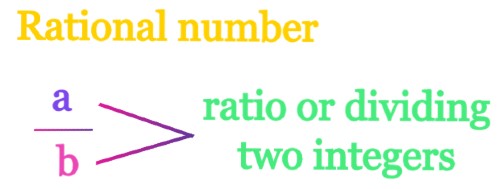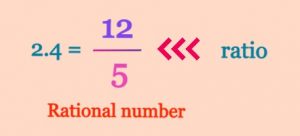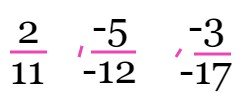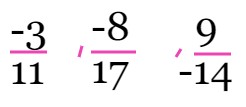Rational numbers hold a significant position in the realm of mathematics, serving as a fundamental and versatile class of numbers. These numbers, often expressed as fractions, form the basis for a wide range of mathematical operations and applications. Understanding the concept of rational numbers is crucial for grasping various mathematical concepts and solving real-world problems effectively.
In this article, we will embark on a journey to explore the world of rational numbers, delving into their definition, properties, and practical examples. By gaining a deeper understanding of rational numbers, we can appreciate their significance and practicality in the fascinating realm of mathematics.
Definition of Rational Numbers
A rational number is a number that can be expressed as a fraction, where the numerator and denominator are both integers. In other words, a rational number is any number that can be written in the form “
What are Rational Numbers?
A rational number is any number that can be written in the form “
The term “rational” stems from the Latin word “ratio,” meaning “ratio” or “quotient.” This definition highlights the essence of rational numbers as ratios of integers.
Rational numbers can be positive, negative, or zero. They can be expressed in different forms, such as proper fractions (where the numerator is less than the denominator), improper fractions (where the numerator is greater than or equal to the denominator), and whole numbers (where the denominator is 1).
The set of rational numbers includes integers, as any integer can be expressed as a fraction with a denominator of 1. For example, the integer 5 can be written as 5/1, making it a rational number. Additionally, terminating decimals and repeating decimals can also be expressed as rational numbers.
Rational numbers include all natural numbers, whole numbers, integers, and all fractions with the positive and negative signs.

Where b is not zero
How to identify rational numbers?
Here is a step-by-step guide on how to identify rational numbers:
- Form of a fraction: A rational number can be expressed as a fraction, where the numerator and denominator are both integers. For example, 3/4, -2/5, and 7/1 are all rational numbers.
- Terminating decimals: A rational number can also be a decimal that terminates, meaning it has a finite number of digits after the decimal point. For instance, 0.75 and -2.5 are rational numbers because they can be expressed as fractions: 3/4 and -5/2, respectively.
- Repeating decimals: Some rational numbers have decimals that repeat in a pattern. These repeating decimals can also be expressed as fractions. For example, 0.333… (where 3 repeats indefinitely) is equal to 1/3, and 0.212121… (where 21 repeats indefinitely) is equal to 7/33.
- Integers: Every integer is considered a rational number because it can be expressed as a fraction with a denominator of 1. For instance, the number 5 can be written as 5/1.
- Closure under operations: Rational numbers are closed under addition, subtraction, multiplication, and division. This means that if you perform any of these operations on rational numbers, the result will also be a rational number.
Types of Rational Numbers
Rational numbers can be further classified into two types: proper rational numbers and improper rational numbers.
- Proper Rational Numbers: Proper rational numbers are those in which the absolute value of the numerator is less than the absolute value of the denominator. They lie within the interval [-1, 1] on the number line. Examples of proper rational numbers include 1/2, 3/4, and -2/7.
- Improper Rational Numbers: Improper rational numbers are characterized by having the absolute value of the numerator greater than or equal to the absolute value of the denominator. They extend beyond the interval [-1, 1] on the number line. Examples of improper rational numbers include 7/3, -5/2, and 11/4.
Arithmetic Operations on Rational Numbers
Arithmetic operations on rational numbers involve applying addition, subtraction, multiplication, and division to these numbers. Rational numbers, being a closed set under these operations, allow for consistent and meaningful calculations. Here’s a breakdown of arithmetic operations on rational numbers:
Addition (+):
To add rational numbers, follow these steps:
- Make sure the denominators of the fractions are the same. If they aren’t, find a common denominator by taking the least common multiple (LCM) of the denominators.
- Multiply each numerator by the appropriate factor to make the denominators equal.
- Add the numerators together, while keeping the common denominator.
- Simplify the resulting fraction, if necessary, by dividing the numerator and denominator by their greatest common divisor (GCD).
Example: Adding 1/3 and 2/5:
- Find a common denominator: LCM(3, 5) = 15.
- Multiply 1/3 by 5/5: (1 * 5) / (3 * 5) = 5/15.
- Multiply 2/5 by 3/3: (2 * 3) / (5 * 3) = 6/15.
- Add the numerators: 5/15 + 6/15 = 11/15.
- The result is 11/15.
Subtraction (-):
To subtract rational numbers, follow a similar process to addition but subtract the numerators instead.
Example: Subtracting 2/3 from 1/2:
- Find a common denominator: LCM(2, 3) = 6.
- Multiply 1/2 by 3/3: (1 * 3) / (2 * 3) = 3/6.
- Multiply 2/3 by 2/2: (2 * 2) / (3 * 2) = 4/6.
- Subtract the numerators: 3/6 – 4/6 = -1/6.
- The result is -1/6.
Multiplication (×):
To multiply rational numbers, multiply the numerators together and the denominators together. Simplify the resulting fraction, if needed.
Example: Multiplying 3/4 by 2/5:
- Multiply the numerators: 3 * 2 = 6.
- Multiply the denominators: 4 * 5 = 20.
- The result is 6/20, which can be simplified to 3/10.
Division (÷):
To divide rational numbers, multiply the first fraction by the reciprocal of the second fraction. In other words, flip the second fraction and then follow the multiplication steps.
Example: Dividing 3/4 by 1/2:
- Flip the second fraction: 1/2 becomes 2/1.
- Multiply the fractions: (3/4) * (2/1) = 6/4.
- Simplify the resulting fraction: 6/4 simplifies to 3/2.
Rational Numbers Examples
- 1\7 is a rational number. Here, a = 1 and b = 7
- -3\8 is a rational number. Here, a = -3 and b = 8
- 2.4 is a rational number because 2.4= 12/5 (12 and 5 are both integers)

Here are some others examples which is given below:
| Number | As a Fraction | Rational? |
|---|---|---|
| 5 | 5/1 | Yes |
| 1.75 | 7/4 | Yes |
| .002 | 1/2000 | Yes |
| −0.1 | −1/10 | Yes |
| 0.111… | 1/9 | Yes |
| √5 (square root of 2) |
? | NO! |
Oops! The square root of 5 cannot be formed as a simple fraction! And there are lots of like this type of numbers, and because they are not rational numbers. These numbers are called Irrational.
Another famous irrational number is Pi (π):
pi(π )= 3.14159265358…
Positive and Negative Rational Numbers
Positive Rational Numbers
The numerator and denominator of a rational number are either both positive or both negative, the rational number said to be a positive rational number.
For Example

Negative Rational Numbers
The numerator and denominator of a rational number are of opposite signs, one positive and other negative, the rational number is called a negative rational number.
For Example

Frequently Asked Questions on Rational Numbers
Are natural numbers rational numbers?
Yes, Every natural number is a rational number.
Is integer a rational number?
Yes, every integer is a rational number.
Is 0 a rational number?
Yes, 0 is a rational number.
Is fraction a rational number?
Yes, every fraction a rational number.
Is 2.4 a rational number?
2.4 is a rational number because 2.4= 12/5 (12 and 5 are both integers).
A fraction is a rational number, but a rational number may or may not be a fraction.
